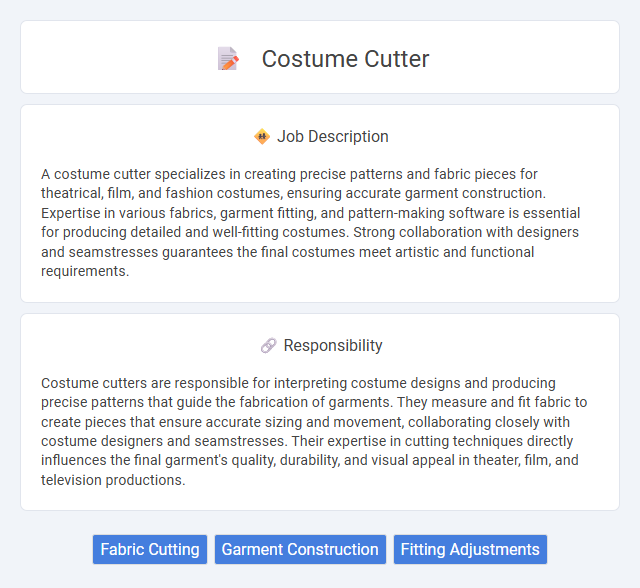
A costume cutter specializes in creating precise patterns and fabric pieces for theatrical, film, and fashion costumes, ensuring accurate garment construction. Expertise in various fabrics, garment fitting, and pattern-making software is essential for producing detailed and well-fitting costumes. Strong collaboration with designers and seamstresses guarantees the final costumes meet artistic and functional requirements.
Individuals with strong attention to detail and manual dexterity are likely suitable for a costume cutter job, as it involves precise cutting of fabrics and materials. People who enjoy working with textiles and have a patience for repetitive tasks may find this role more fitting. However, those who struggle with standing for long periods or have limited hand-eye coordination might face challenges in this profession.
Qualification
A costume cutter position requires expertise in pattern making, fabric selection, and precision cutting techniques to ensure garments fit design specifications perfectly. Candidates must have proficiency with industrial cutting tools, strong attention to detail, and experience working with various textiles commonly used in theater, film, or fashion. Formal training in costume design, fashion technology, or related fields, along with practical experience in costume production, significantly enhances job qualifications.
Responsibility
Costume cutters are responsible for interpreting costume designs and producing precise patterns that guide the fabrication of garments. They measure and fit fabric to create pieces that ensure accurate sizing and movement, collaborating closely with costume designers and seamstresses. Their expertise in cutting techniques directly influences the final garment's quality, durability, and visual appeal in theater, film, and television productions.
Benefit
A costume cutter job likely offers the benefit of creative fulfillment, as individuals have the opportunity to work closely with designers to bring unique visions to life. This role probably provides skill development in fabric manipulation and pattern making, enhancing one's expertise in the fashion and theatrical industries. The position may also offer a collaborative work environment, enabling continuous learning and professional growth.
Challenge
Costume cutters likely face the challenge of accurately interpreting designers' visions while maintaining precise measurements to ensure garments fit perfectly. They probably encounter difficulties in managing complex fabric types that require careful handling to avoid damage during cutting. Meeting tight deadlines while preserving high-quality workmanship may also present a significant challenge in this role.
Career Advancement
Costume cutters specialize in creating precise garment patterns, essential for theater, film, and fashion productions, making their skills highly valuable in the entertainment and design industries. Career advancement opportunities include progressing to roles such as costume designer, wardrobe supervisor, or production manager, where leadership and creative direction are paramount. Mastery of complex fabric manipulation and strong collaboration with designers and directors enhances prospects in high-profile projects and larger production companies.
Key Terms
Fabric Cutting
Fabric cutting in a costume cutter job requires precision and attention to detail to ensure each pattern piece fits perfectly within the fabric's grain and design. Expert knowledge of various textiles such as silk, cotton, and synthetic blends allows costume cutters to optimize fabric usage while minimizing waste. Proficiency in manual and automated cutting techniques, combined with sharp cutting tools, guarantees clean edges and accurate shapes essential for high-quality costume construction.
Garment Construction
Costume cutters specialize in garment construction by precisely interpreting design sketches and patterns to create fabric templates used in assembling costumes. They apply expert knowledge in fabric behavior, pattern grading, and seam allowances to ensure accurate cutting that aligns with the costume designer's vision and performance requirements. Mastery of various textile materials and garment construction techniques allows costume cutters to produce durable, well-fitted pieces essential for stage, film, and theatrical productions.
Fitting Adjustments
Costume cutters specialize in precise fitting adjustments to ensure garments conform perfectly to performers' bodies, enhancing comfort and visual appeal on stage or screen. They skillfully modify patterns and fabric during fittings to accommodate movement and character requirements, maintaining the integrity of the original design. Expertise in fabric behavior and tailoring techniques is crucial for achieving seamless, functional costumes crucial for performance.
 kuljobs.com
kuljobs.com